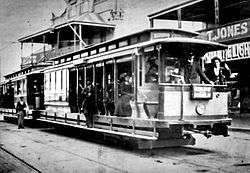Sydney G-Class Tram
The G-class trams were a class of single ended cars were designed to operate either permanently coupled back to back in pairs or singly hauling a trailer on lines with reversing arrangements at the terminii.[1]
| G-class | |
|---|---|
 G128 & G129 | |
| Manufacturer | American Car Co J. G. Brill and Company |
| Constructed | 1899 |
| Number built | 16 |
| Fleet numbers | 124-139 |
| Capacity | 51 later 49 (Seated) |
| Specifications | |
| Train length | 23 ft 3 in (7.09 m) |
| Height | 12 ft 1.5 in (3.70 m) |
| Maximum speed | 60 km/h |
| Weight | 12.6 long tons (12.8 t) |
| Power output | 4 x 42 hp (later 48) |
| Electric system(s) | 600 V DC catenary |
| Current collection method | Pantograph |
| Track gauge | 1,435 mm (4 ft 8 1⁄2 in) |
History
The G class trams were imported from the United States for the electrification of George Street. They were originally allocated to Ultimo Tram Depot, later moving to Newtown and Tempe. All were withdrawn by 1927.[2]
As they only had driving controls at one end, they operated in pairs. Two (124 and 125) were fitted with dual controls to operate tourist services in 1905.
Numbers
- American Car Company: 124-131
- J. G. Brill and Company: 132-139
gollark: Randomized carpools vs ghostwritten checkmates?
gollark: What's statbot?
gollark: Relevant cactus vs general calamities?
gollark: Realistic communism vs gray cormorants?
gollark: Remote control vs garden cleaning?
References
- McCarth & Chinn (1974). New South Wales Tramcar Handbook 1861-1961. SPER.
- MacCowan, Ian (1990). The Tramways of New South Wales. Oakleigh: Ian MacCowan. p. 119. ISBN 0 949600 25 3.
Further reading
- Chinn, N (1975). New South Wales Tramcar Handbook 1861-1961. Vol. 1. South Pacific Electric Railway Cooperative Society. ISBN 9780959865967.
- McCarthy, Ken (1976). New South Wales Tramcar Handbook 1861-1961. Vol. 2. South Pacific Electric Railway Cooperative Society. ISBN 9780959865974.
External links
![]()
This article is issued from Wikipedia. The text is licensed under Creative Commons - Attribution - Sharealike. Additional terms may apply for the media files.